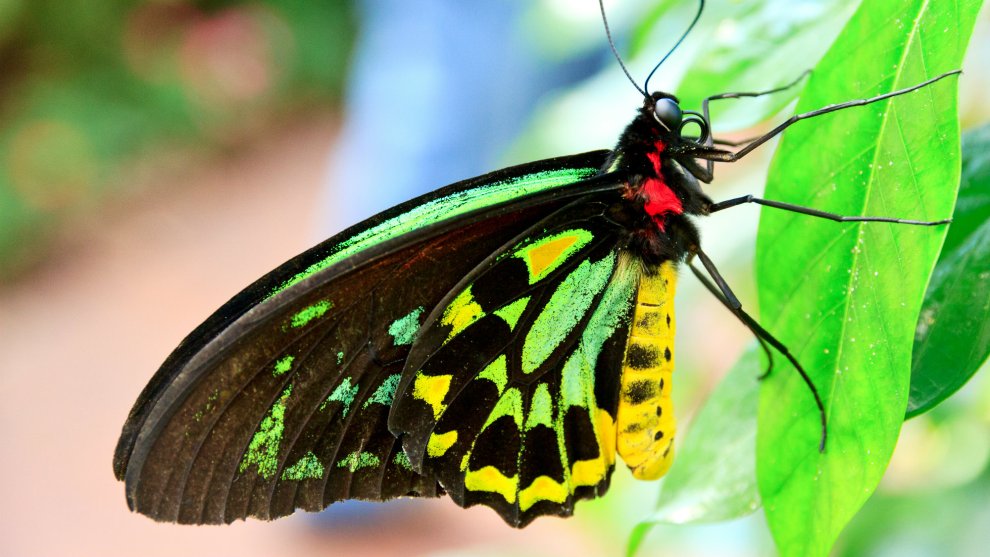The QAB has an impressive wingspan of 12 inches (roughly 30.50 cm) but little else is known about this rare beauty. According to the Birdwing article in Mother Jones, "The world’s butterflies are under intense pressure from habitat destruction and other environmental threats, with many populations dwindling rapidly and others vanishing before our eyes. One recent study found an estimated 33 percent decline in common butterflies in Ohio from 1996 to 2016, a rate consistent with worldwide patterns. These losses have disturbing repercussions for crop pollination and the health of ecological systems." So the world isn't just losing too many bees, we are also losing too many butterflies; a potentially deadly situation.
The QAB inhabits the forests of Papua, New Guinea. "Its wings are adorned in iridescent blue-green and yellow. And its caterpillars are equally impressive, with large black bodies broken by a yellow saddle and long red spikes. Its stunning beauty, along with its habitat in a remote and mysterious location" are compelling reasons why it needs to be included in extensive research and made a top candidate for the list of the rarest butterflies. The QAB was discovered in 1906 by British naturalist, Albert Meeks. His 1913 book, A Naturalist in Cannibal Land, focuses on his nearly 2 decades of work in Papua, New Guinea where the primary focus of his research was on butterflies, especially the birdwing.
"To immobilize large butterflies, indigenous people fashioned nets by lashing spiders’ webs around sticks. Meek had other methods. One day, he saw a large butterfly flying in the forest canopy out of reach of a net, so he took aim with a shotgun and blasted it out of the air. The resulting holes and rips in the wings of that first Queen Alexandra’s Birdwing specimen are on view today at the Natural History Museum in London."
For the six decades after its discovery, no further attempts were made to quantify the Queen Alexandra Birdwing butterfly, even though it was then known to be rare and unique." In 1968, under the new Fauna Protection Ordinance put in place by the Australian government of Papua New Guinea (the country would gain its independence in 1975), its collection was made illegal." Then, in 1970 efforts began to map the QAB population which was limited to the two populations around the eastern city of Popondetta: one on the Popondetta Plain, the other to the south over a volcanic mountain on the Managalas Plateau.
Fast-forward to 1992. Scientists encountered only 150 of these butterflies in a 10-day period and slightly lower numbers by the late 1990s. By the mid-2000s, scientists found even fewer.
"In 2008, conservation biologist Tyler Hicks spent three months searching for the Queen Alexandra’s Birdwing and observed a mere 21 adults, and fewer than one butterfly per acre. If accurate, this estimate would undoubtedly make it one of the rarest butterflies in the world."
The greatest threat to the QAB is tree harvesting which has accelerated in recent years with the expansion of the palm oil industry. "Oil palm (Elaeis guineensis)—the fruit of which produces cooking oil, packaged foods, soaps, and more—transforms forests into uniform plantations. These plantations have grown to occupy thousands of acres in the core of the butterfly’s range and create a sterile environment, destroying the butterfly’s food supply and habitat and effectively eliminating any chance for its survival."
In many countries, conservation efforts could be furthered by buying up land parcels for stewardship by government agencies or non-profit organizations. In Papua New Guinea, however, tribal clans own and control nearly the entire country, with each clan working vigorously to protect its own land, which is defined by natural borders and is inherited by other clan members.
"One potential solution is to encourage clans to harness the financial value of the Queen Alexandra’s Birdwing, which is further suffering from a continuing trade on the black market. Because of their beauty and rarity, butterflies that sold in the 1980s for up to $3,000 have more recently gone for a whopping $10,000 a pair. That sets it apart from other extremely rare species, which are of little comparative value." To accomplish this, however, tribal clans would have to create a habitat for the butterflies.
It is alarming how little is known about the Queen Alexandra Birdwing or, for that matter, the viability of other butterflies in remote tropical regions. Researchers, naturalists, as well as conservation groups, all need to sit up and take notice. Rare and beautiful species are disappearing before our very eyes and much of it is due to neglect. Vigilance and perseverance can pay big dividends, though, and it is up to you humans to push for stricter legislation protecting endangered species and to support conservation efforts.
The animal world relies on you. They can't do it themselves. So I am urging each of you to speak out against governmental policies, wherever you live, that hurt endangered species and promote the loss of our habitats...all in the name of greed.
Saturday is National Dance Day and there's nothing I enjoy doing more than dancing. I have been known to show up at flash mobs all around the swamp. Dancing lifts the spirits and is a superb and endlessly entertaining way to get exercise. I hope you'll stop by tomorrow where my blog will celebrate dance. Until then, I wish you
PEACE.

 RSS Feed
RSS Feed